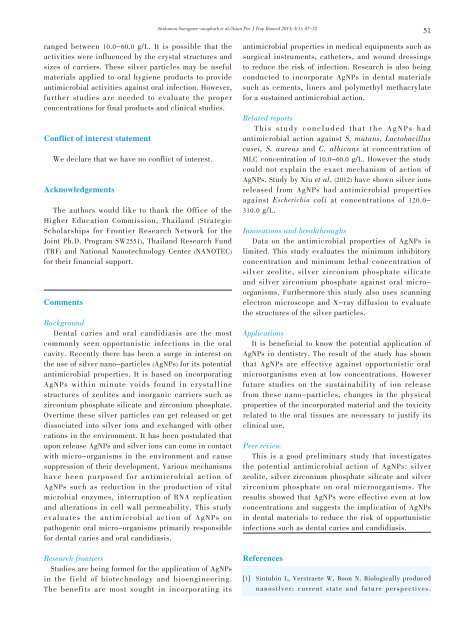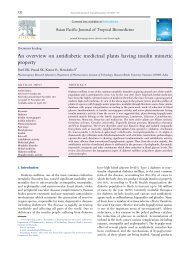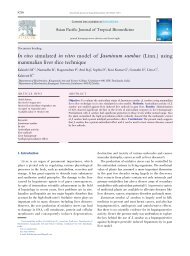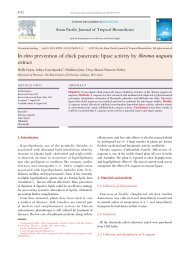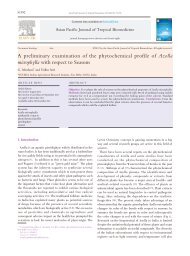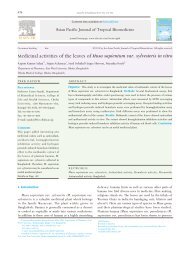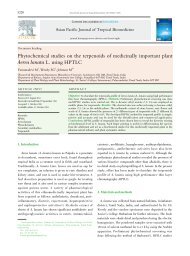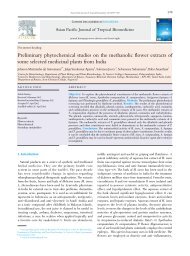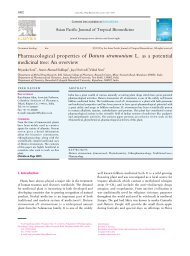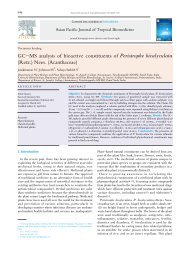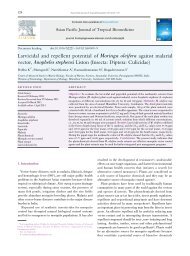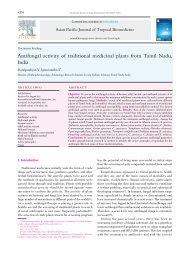Antimicrobial effects of silver zeolite, silver zirconium phosphate ...
Antimicrobial effects of silver zeolite, silver zirconium phosphate ...
Antimicrobial effects of silver zeolite, silver zirconium phosphate ...
Create successful ePaper yourself
Turn your PDF publications into a flip-book with our unique Google optimized e-Paper software.
Sirikamon Saengmee-anupharb et al./Asian Pac J Trop Biomed 2013; 3(1): 47-52<br />
51<br />
ranged between 10.0-60.0 g/L. It is possible that the<br />
activities were influenced by the crystal structures and<br />
sizes <strong>of</strong> carriers. These <strong>silver</strong> particles may be useful<br />
materials applied to oral hygiene products to provide<br />
antimicrobial activities against oral infection. However,<br />
further studies are needed to evaluate the proper<br />
concentrations for final products and clinical studies.<br />
Conflict <strong>of</strong> interest statement<br />
We declare that we have no conflict <strong>of</strong> interest.<br />
Acknowledgements<br />
The authors would like to thank the Office <strong>of</strong> the<br />
Higher Education Commission, Thailand (Strategic<br />
Scholarships for Frontier Research Network for the<br />
Joint Ph.D. Program SW2551), Thailand Research Fund<br />
(TRF) and National Nanotechnology Center (NANOTEC)<br />
for their financial support.<br />
Comments<br />
Background<br />
Dental caries and oral candidiasis are the most<br />
commonly seen opportunistic infections in the oral<br />
cavity. Recently there has been a surge in interest on<br />
the use <strong>of</strong> <strong>silver</strong> nano-particles (AgNPs) for its potential<br />
antimicrobial properties. It is based on incorporating<br />
AgNPs within minute voids found in crystalline<br />
structures <strong>of</strong> <strong>zeolite</strong>s and inorganic carriers such as<br />
<strong>zirconium</strong> <strong>phosphate</strong> silicate and <strong>zirconium</strong> <strong>phosphate</strong>.<br />
Overtime these <strong>silver</strong> particles can get released or get<br />
dissociated into <strong>silver</strong> ions and exchanged with other<br />
cations in the environment. It has been postulated that<br />
upon release AgNPs and <strong>silver</strong> ions can come in contact<br />
with micro-organisms in the environment and cause<br />
suppression <strong>of</strong> their development. Various mechanisms<br />
have been purposed for antimicrobial action <strong>of</strong><br />
AgNPs such as reduction in the production <strong>of</strong> vital<br />
microbial enzymes, interruption <strong>of</strong> RNA replication<br />
and alterations in cell wall permeability. This study<br />
evaluates the antimicrobial action <strong>of</strong> AgNPs on<br />
pathogenic oral micro-organisms primarily responsible<br />
for dental caries and oral candidiasis.<br />
Research frontiers<br />
Studies are being formed for the application <strong>of</strong> AgNPs<br />
in the field <strong>of</strong> biotechnology and bioengineering.<br />
The benefits are most sought in incorporating its<br />
antimicrobial properties in medical equipments such as<br />
surgical instruments, catheters, and wound dressings<br />
to reduce the risk <strong>of</strong> infection. Research is also being<br />
conducted to incorporate AgNPs in dental materials<br />
such as cements, liners and polymethyl methacrylate<br />
for a sustained antimicrobial action.<br />
Related reports<br />
T h i s s t u d y c o n c l u d e d t h a t t h e A g N P s h a d<br />
antimicrobial action against S. mutans, Lactobacillus<br />
casei, S. aureus and C. albicans at concentration <strong>of</strong><br />
MLC concentration <strong>of</strong> 10.0-60.0 g/L. However the study<br />
could not explain the exact mechanism <strong>of</strong> action <strong>of</strong><br />
AgNPs. Study by Xiu et al. (2012) have shown <strong>silver</strong> ions<br />
released from AgNPs had antimicrobial properties<br />
against Escherichia coli at concentrations <strong>of</strong> 120.0-<br />
310.0 g/L.<br />
Innovations and breakthroughs<br />
Data on the antimicrobial properties <strong>of</strong> AgNPs is<br />
limited. This study evaluates the minimum inhibitory<br />
concentration and minimum lethal concentration <strong>of</strong><br />
<strong>silver</strong> <strong>zeolite</strong>, <strong>silver</strong> <strong>zirconium</strong> <strong>phosphate</strong> silicate<br />
and <strong>silver</strong> <strong>zirconium</strong> <strong>phosphate</strong> against oral microorganisms.<br />
Furthermore this study also uses scanning<br />
electron microscope and X-ray diffusion to evaluate<br />
the structures <strong>of</strong> the <strong>silver</strong> particles.<br />
Applications<br />
It is beneficial to know the potential application <strong>of</strong><br />
AgNPs in dentistry. The result <strong>of</strong> the study has shown<br />
that AgNPs are effective against opportunistic oral<br />
microorganisms even at low concentrations. However<br />
future studies on the sustainability <strong>of</strong> ion release<br />
from these nano-particles, changes in the physical<br />
properties <strong>of</strong> the incorporated material and the toxicity<br />
related to the oral tissues are necessary to justify its<br />
clinical use.<br />
Peer review<br />
This is a good preliminary study that investigates<br />
the potential antimicrobial action <strong>of</strong> AgNPs: <strong>silver</strong><br />
<strong>zeolite</strong>, <strong>silver</strong> <strong>zirconium</strong> <strong>phosphate</strong> silicate and <strong>silver</strong><br />
<strong>zirconium</strong> <strong>phosphate</strong> on oral microorganisms. The<br />
results showed that AgNPs were effective even at low<br />
concentrations and suggests the implication <strong>of</strong> AgNPs<br />
in dental materials to reduce the risk <strong>of</strong> opportunistic<br />
infections such as dental caries and candidiasis.<br />
References<br />
[1] Sintubin L, Verstraete W, Boon N. Biologically produced<br />
nano<strong>silver</strong>: current state and future perspectives.


